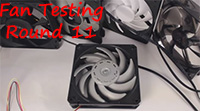So we have looked at elbow restriction impacts before, but not in close proxity to the pump. We have seen that replacing the factory elbow inclusive DDC top with one that is aftermarket provides significant performance improvements, yes there is still a need for them in certain installations. This article is devoted to exploring the effects of elbows and port alternatives of the DDC pump.
A special thanks to my sponsors:
ENERGY LOSSES
Normally an elbow in the system is nothing more than friction or pressure drop. It is relatively small and for most users ignored if only a few are used. However, elbows are more important at the pump because the cause both restriction and ditsturb the flow within the conduit. Undisturbed flow within a long piece of tubing has a very even conical shaped velocity profile where the velocity is highest away from the walls at the center if the tube. The introduction of an elbow however disturbs that. The result is you get more flow off to one side. At the inlet of a pump this means the impeller is loaded slightly off balance and causes a loss of efficiency. How much loss likely depends on how close the elbow is to the impeller, how sharp a bend it is, and how small the ID.
Another potential problem with elbows at pump inlets has to do with cavitation. Pumps create a “differential” pressure which means a negative pressure at the pump inlet and posotive at the pump outlet. Negative pressure if strong enough can cause water to boil at room temperature. You might recall such an experiment in high school chemistry where using a vacuum chamber caused water to boil. This is what causes cavitation. In a pump however it only appears in the form of noise because the pressure increases very dramatically as it passes the impeller. You get a bacon sizzle type noise which is air bubbles forming that almost instantaneousouly form and collapse back to a fluid. Cavitation is of high concern in large industrial pumps because it can cause corrosion of the impeller. In water cooling, it more of an issue of causing unwanted noise and possibly some loss in efficiency. I have yet to see a worn impeller myself and have typically only witnessed cavitation in testing under extremely high flow and low restriction conditions that are not normally found in real world systems.
So..we have restriction losses which are fairly small, impeller loading losses which can be significant, and possible cavitation issues assocoated to pumps with elbows. To explore this, I figured on the normal PQ curve testing and simply add elbows or change ports and see what the results are…
TOPS WITH ALTERNATE PORT OPTIONS
My first look is using th Koolance COV-RP400 and Koolance PMP-400 (DDC 3:25) pump top. Some tops offer what I would call “Internal Elbows”, which allows the user to modify the port orientation using supplied port plugs and simply installing the barbs in the preferred orientation and there is no need for additional elbow fittings.
First, let us have a look at the factory top. The top is designed with XXmm ID ports, the outlet is tangential and in plane to the impeller, however the inlet includes a small ID 90 elbow integrated into the top. It is radiused, but the ID is small and very close to the impeller.
